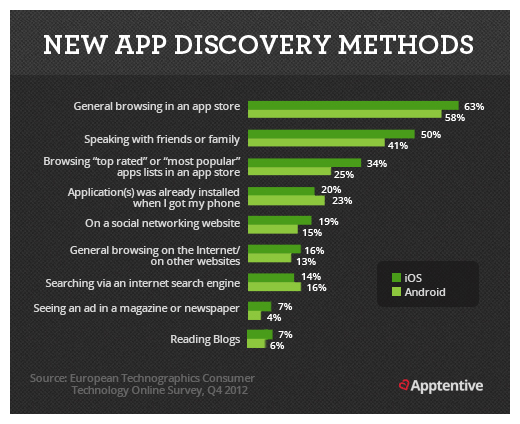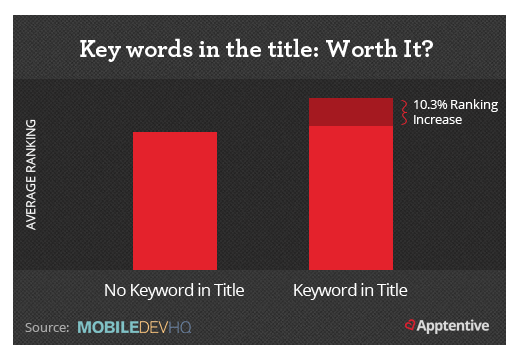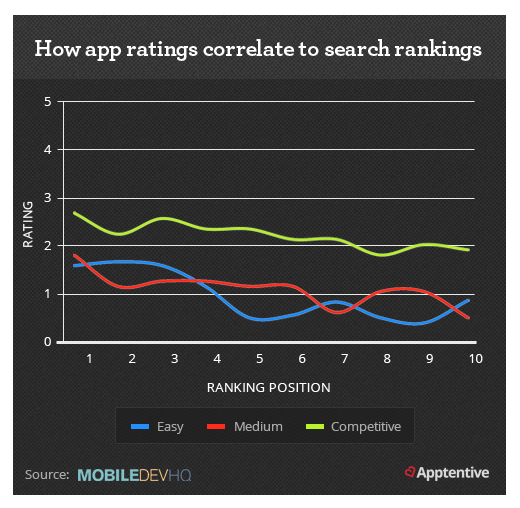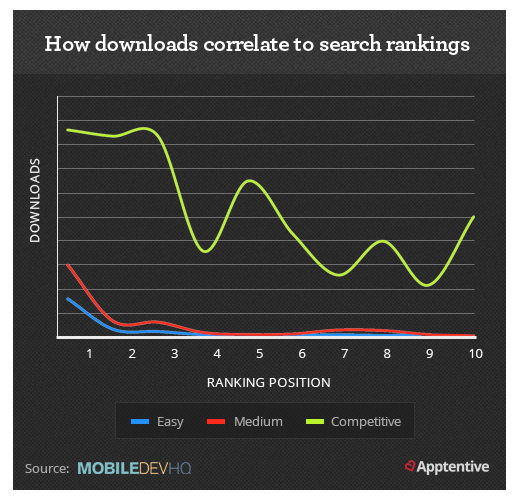With over 2 million mobile apps in the major app stores, getting your app discovered is one of the biggest issues facing mobile app publishers today. If you’re in the mobile app space, it’s important to understand the various methods for marketing your app. We’d like to share with you one very important technique that continues to be overlooked by most – app store optimization (or ASO for short).
More apps are discovered through search than any other method
So, what is ASO?
ASO is the process of optimizing mobile apps to rank higher in an app store’s search results. The higher your app ranks in an app store’s search results, the more visible it is to potential customers. That increased visibility tends to translate into more traffic to your app’s page in the app store.
The goal of ASO is to drive more traffic to your app’s page in the app store, so searchers can take a specific action: downloading your app.
Also, the ASO process requires a crucial understanding of your target customer base, including the keywords your potential customers are using to find apps similar to yours. When you learn more about which keywords are being used, you will have a better understanding of the language of your potential customers – a crucial piece of any marketing plan – and you can home in on your keyword choices.
Why is ASO important?
According to Forrester, 63% of apps are discovered through app store searches. This makes search, in the app store, the most used method for discovering and downloading new apps. Recently, at Google I/O, Ankit Jain reported that “For the average app, search actually makes up the vast majority of installs.” Simply put, this means that:
If you’re not using ASO to increase your app’s search ranking, you’re missing out on the largest discovery channel available to your app.
With hundreds of thousands of apps in each app store vying to rank above one another, the amazing reality is that the majority of publishers are not investing in app store optimization. So here’s our gift to you: ASO is your secret weapon. Spend time every week improving your ASO, and you will meaningfully impact your app’s ranking and overall success.
What are the mechanics of ASO?
Let’s start by breaking down the various components that can affect your ASO:
Main Factors:
- Title – The keyword placed in the title should be the one with the heaviest search traffic. Spend time researching which keyword that is, because changing your title often to include different keywords can be detrimental. As your app begins to rank higher and gain more reviews, news of your app will begin to spread by word of mouth. Changing the title can make it difficult for word to spread about your app.
- Keywords – To improve your search rankings, you need to know which keywords are relevant and used most often by your target audience. It is helpful to monitor competitors in order to realize how you compare week to week.
In addition to being the most important factors for ASO, the fact that the title and keywords can be modified easily means that you can regularly optimize them.
Secondary Factors:
- Total # of Downloads – Your number of downloads are extremely important to ASO, but you don’t have complete control over them.
- Ratings and Reviews – Also important and difficult to control. However, there are ways to incentivize happy users to rate and review.
Let’s Talk About Keywords in the Title: Worth It?
With a sampling of keywords, they looked at the top 25 ranking positions and calculated what percentage of apps had the keyword in the title vs. those that did not. This provided a total aggregate score for the apps with the keyword in the title and the apps without the keyword in the title.
Based on this test, apps with keywords in the title ranked on average 10.3% higher than those without a keyword in the title.
So, is a keyword worth placing in your title? Yes.
Do apps with higher ratings rank higher in search results?
This test was done by taking a random sampling of keywords and categorizing them by difficulty as related to result count. An “easy” keyword results in fewer than 25 apps trying to rank for that keyword. “Medium” keywords are those that are included in 25-100 apps, and “competitive” keywords are those in 100+ apps.
Based on this test, there is a clear trend showing that apps with higher ratings also rank higher for keyword difficulty.
Do apps with better ratings rank higher? Yes.
(But don’t beg for them; earn better ratings for your apps the right way.)
Do more downloads correlate to higher app store search rankings?
Only the developer and the app store know the number of times an app has been downloaded. Since we do not know the number of downloads, we took the number of ratings instead. The belief here is that, averaged out, the download-to-rating conversion rate is more or less similar across most apps. Therefore, it is fairly accurate to look at the number of ratings as a proxy for the number of downloads.
Again, the results of the test are clear. The trend, regardless of difficulty, showed that apps with more downloads also rank higher.
Do apps with more downloads rank higher? Yes.
It is important to notice the difference between “competitive” keywords and the other difficulties. If your keyword falls into the “competitive” category, you need a significantly larger number of downloads to rank higher.
Keep in mind that ASO takes time
ASO is a process that needs to be monitored and constantly tweaked over a period of time. Your optimal set of keywords rarely is the set that you first opt to put in the app store.
Today, the most common approach to ASO is no approach at all. Developers often pick keywords and write descriptions at the last second during an app’s submission process. In most cases, little or no research on keyword searches occurs before the app submission, leaving most apps hidden and the likelihood of discovery quite low.
We had a moment to sit down with Ian Sefferman, the CEO of MobileDevHQ, and he told us how investing time in ASO has affected their customers. He said:
“ASO is having dramatic effects on our client apps. For those who put the time in to understand, iterate, and test, we’ve seen many apps increase their downloads by a factor of 2x-10x, and an increase of revenue by a similar, or bigger, rate due to the increase in engagement of users earned by ASO. ASO is not a simple process, and you might not see the impact overnight, but if you’re willing to invest in it, the outcome can be incredibly worthwhile.”
App developers need to consistently track their own rankings and the rankings of their competitors over time. More apps are published every day, and the constant stream of new ratings, reviews, and downloads can affect your search rankings. Keep testing and experimenting with your keywords in order to consistently rank well and drive more traffic to your download page.
Tips for improving your ASO
To recap, let’s look at the ASO factors and the methods you can use to improve in those areas.
Main Factors
- Title – Having a keyword in your title can improve your app’s search ranking for that keyword by an average of 10.3%. As a best practice, you want to place your most relevant keyword, regardless of the keyword difficulty, in the title.
- Keywords – Constantly tracking your own keywords and the movement of your competitors takes time and effort. In order to have the time to focus on your app and not solely on ASO, use a service such as MobileDevHQ to track your search rankings, analyze your keywords, choose better keywords, and get updates about your competitors.
Secondary Factors
-
- Total # of Downloads – Now that our gut feelings have been proven with data, what can you do to get more downloads for your app? Improving your ASO is a great place to start. Beyond that, it is about marketing your brand and app to improve recognition, awareness, and appeal, from app store description to images, ratings/reviews, and social media presence. For a great place to start, check out these three inbound marketing strategies for mobile apps.
- Ratings and Reviews – As we saw above, apps with higher ratings also ranked higher. This raises a tricky dilemma: you want more ratings and reviews but not if they are negative. So, you need a way to connect with your customers inside your app, giving them a place to vent and talk directly to the developer. On the flip side, you want to guide happy customers to leave positive reviews for you.
To reap the rewards of ASO, you need to invest time and effort. If you do, you’ll have a consistent channel driving traffic to your app. Being found is one of the most difficult challenges for mobile apps, but it is a problem you can actively solve.
About the Author: Robi Ganguly is the CEO of Apptentive, the easiest way for every company with an app to talk with their customers. When he’s not at the office, you can find him running, reading, cooking, spending time with friends, or hanging out on Twitter (@rganguly).




Comments (85)